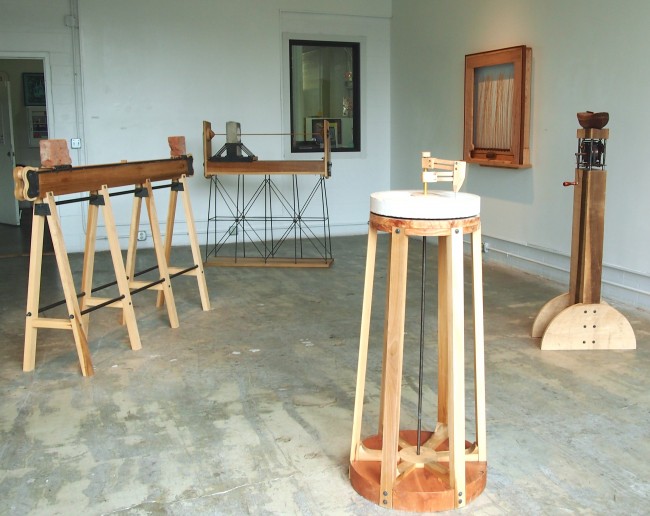“Jim Killy: Mostly Wood”
By Larry Watson

As I began to wander the gallery at Brazee Studios, a young lady, Kayla, age 7, starts interacting with the sculptures with little hesitation, immediately reaching up and sliding the half-brick forward on a long, metal track, while instructing her mother to do the same with the opposing piece. As the pieces meet, the recognition of a match between the two halves is clear, though the edges are worn, testimony to time and trauma. When released from the temporary reunion, the pieces are drawn apart on their wheeled tracks by the internal mechanism, their momentum gently arrested by the spring loaded bumper at the end of the track.
This moment perfectly illustrates the playful nature of Jim Killy’s work in this exhibit. The accessibility of the sculptures creates an intimacy that is not possible with “don’t touch” art, and the kinetic interaction becomes a primary element.
The title of this first piece is Reunion. Returned to their resting places, each half-brick is held in place at each end of the track by inertia and the gentle pull of the unseen internal forces that require desire and intention to overcome. It is easy to anthropomorphize these traits, to complete a human parallel with the inanimate object. Or am I projecting my own interpretations onto Killy’s work? Consider it artistic license, if you will, since the artist provides no indication of analogies or metaphors. So I will indulge myself.
In Reunion, there is a contrast of age and timelessness presented by the worn, aged brick (the brick’s historic origin is documented in its description) and the simply-machined wood and metal components. The exposed joinery seems to portray a strength, and a disregard for embellishment; perhaps a form-follows-function approach to assembly. Though some of the pieces hide the mechanics of the moving parts, the rest of the construction is laid bare like a powerful skeleton, with steel reinforcements bolted through stout wooden legs rising from the floor to view-level (which is eye-level for young Kayla). Their components and methods of construction imply longevity.
The appearance of the impetuous young lady provided the delight of seeing how simple curiosity unleashes with innocence the mechanical properties of these sculptures. It was humbling to recognize that each person might have a unique perspective and interpretation of these sculptures, and it aroused my curiosity.
Strategic Alignment holds a stone on a wheeled track, and a hole in the stone runs along a dowel that turns within the hole. The hidden mechanisms convert the hand crank into lateral motion while the dowel spins inside the hole. The hole shows a vortex of deep wear and tear disproportionate to the materials at hand, and creates a sense of age and of antiquity. Yet, there is no use.
This appears to be a theme of Killy’s exhibit; there is no product, there is no finished piece to it. It is in motion, creating an anticipation of results. The only result is the visual impression; a visual imprint on the retina, a fleeting kinetic memory. The mental-muscle memory of our industrial evolution has created this expectation that mechanical things in motion perform useful functions and products. The absence of outcome transmutes the perception of production to an experience of play, holding both/and in a fragment of time.
It disappears once the hand is removed from the object. There is no longer the motion; it was only for that moment and can be repeated as often as desired, but without human interaction, it is audibly and kinetically mute.
The mystery of the artist’s intention is effective in many of the pieces. The object is pointing a finger at what it is about, but there is nothing there save what goes on in the viewer. There is nothing in this very non-visceral physical display to indicate, to show, to point to the end meaning or intention. The lack of meaning or intent leaves the viewer the responsibility to furnish it at a visceral level.
As you turn the handle on The Other Side of The Fence, a round table full of wooden marbles turns and tilts in a seemingly random directions, creating a cacophony when the marbles clatter through the fence in spontaneous and unpredictable ways. The temptation is to try to control where the marbles go. The human temptation, the human desire, is to have control of an intentional outcome. Within the paradigm of that control issue, the process creates panic. Once the control issue is surrendered, the process creates entertainment.
Kayla continued to personally engage the sculptures, intuitively finding the mechanisms that bring the art pieces, and the imagination, to life with motion and sound. Each piece rattled and scraped and rolled, echoing sharply off the high steel roof, adding another element of now-ness to the work. Breaking the rule of silence and stillness normally associated with galleries, the vibration and action brought out the temporary nature of interaction, returning to silence as Kayla, and, eventually, I, left the building.